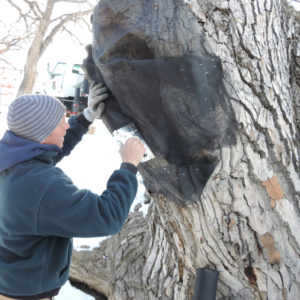
On a gray January morning, Chad Street stands in the dry Allen Ditch along 88th Street in front of what will soon become the new Westminster town center and mall. He pokes his head inside a foot-wide cavity in the standing trunk of a 130-year-old cottonwood, home to as many as 40,000 feral black bees.
“That should be the one main entrance,” he says. “You can see the comb. They should be super, super calm. Above 40 to 50 degrees, and they’ll start flying.”
Street rolls up a section of black screen material and carefully pushes it into the cavity. He then opens up the 3-by-3-foot screen and begins to staple it around the perimeter of the hollow opening.

Cranes swing overhead, construction vehicles sound warnings and steel workers pound beyond the construction fence while traffic whizzes past — all oblivious to the rescue efforts underway.
Street, arborist and owner of Longmont-based Bees and Trees, was called in by City of Westminster Forester John Kasza to save the bees residing in the hollow stump, slated for removal in order to create an alleyway into the mall. The 10,000-pound stump, which stands about 12 feet high with a girth of 8 feet, is part of a row of old cottonwoods that have been growing along the ditch for the past 130 years. When the city purchased the property five years ago, the original plan was to clear out all of the mature cottonwoods, Kasza says.
“This is going to become the downtown Westminster never had,” he explains. Looking up at the dark branches extending into the gray sky, Kasza says he believes there are additional hives and wildlife up in the hollows of the remaining cottonwoods. “In the next tree over, we have a hawk’s nest,” he says.
So, as the old mall comes down to make way for the new, Kasza says the City has taken extra effort to try to save the trees and hives “just to be good stewards of the land and animals.”
Street and fellow arborist Dennis Shea proceed to cut off the protruding branches on opposite sides of the broad stump to reduce its weight and girth. The bees “won’t like the sound (of the chain saws) and the fact that we’re cutting into their home,” Street says.
One section of the tree after another falls heavily to the ground and rolls into the ditch. Meanwhile, the bees and Street, who says he’s probably been stung 1,000 times (about 100 times each season) remain nonplussed. “Generally, if you’re calm, they’re calm,” he says.
According to Street, the feral bees inside are most likely German black bees that escaped managed hives and became naturalized over time. “German black bees were the first honeybees that had been brought to North America,” he says. Although there are about 900 native bee varieties found in Colorado, “No honey bees — European honey bees — are native to North America,” he says. “The darker the bee, the more natural it is.”

As Shea continues taking wedge-shaped cuts out of the high side of the stump, Street, standing in the ditch, makes several small cuts with the tip of his chain saw blade probing into the center of the hollow trunk. He estimates the honeycomb extends 4 feet down into the trunk from the hole that he had previously covered. He hesitates, licking his lips. “My chain saw bar was definitely sweet,” he says.
A few weeks later, Street pulls back a tarp draped over the bisected section of the cottonwood that he hauled in his trailer to his home just south of Longmont. “That’s just to keep them warm,” he says. Street, who has over 10 bee boxes and another seven hives still living in tree trunks, says he may try to transfer the queen, hive and a piece of the comb to a box if the hive survives this winter.
“I think tree guys have a unique opportunity to have access to bees,” he says. Even though fast growing trees like cottonwoods, willows, silver maples and elms are the most likely to provide habitat for bees and raptors, he says, they can often become a liability near houses or in urban areas. If a cavity is in the main stem of the tree, it may be hazardous and have to come down. “I would sure like to save more trees,” he says.
Street, who with his wife participates with the Longmont Coalition for People and Pollinators, says bees are under stress for a number of reasons including habitat loss, use of chemicals, “weird weather,” transporting of hives and invasive beetles and mites.
“Last year I would’ve said, ‘Start a hive.’ That’s not helping them,” he says. “We need more habitat.”
This spring, when he’s not saving bees from trees like the one from Westminster, Street plans to plant wild plum trees, serviceberries and rabbitbrush to support his bees in their adopted home. Street looks around his property with the stumps, bee boxes, tree equipment, and the tall elms and conifers along his property lines.
“It’s alfalfa behind us,” he says. “I want it to be all wildflowers.”














